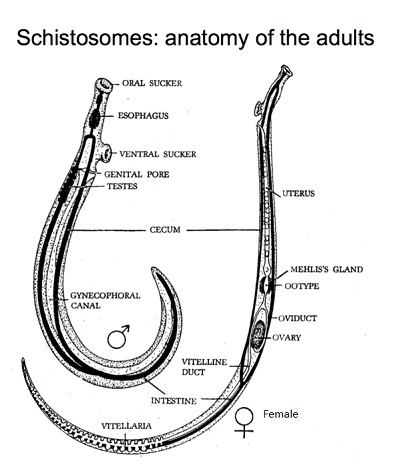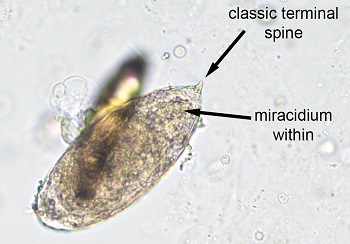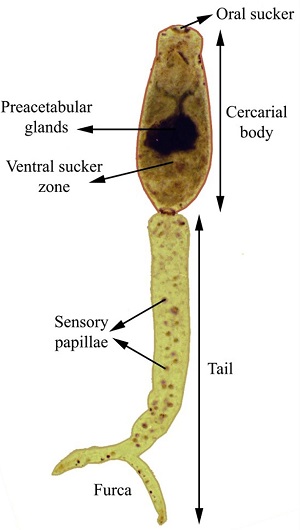Schistosoma haematobium - Introduction, Classification, History, Habitat, Morphology
Introduction of Schistosoma haematobium
Schistosoma haematobium is a parasitic blood fluke and the causative agent of vesical or urinary schistosomiasis. The flukes live in the vascular system (portal blood) of humans and other vertebrates. The characteristics of Schistosoma include:
unisexual (diecious) – male holds female in the gynecophoral canal
in males, the number of testes varies from 4 to 8
in females, Laurer’s canal is absent
eggs are non-operculate, fully embryonated when laid
cercariae are pharyngeal cause infections in the host by penetration through unbroken skin
muscular pharynx and the encysted metacercarial stage is absent
Classification of Schistosoma haematobium
Kingdom: Animalia
Phylum: Platyhelminthes
Class: Trematoda
Order: Diplostomida
Family: Schistosomatidae
Genus: Schistosoma
Species: S. haematobium
History of Schistosoma haematobium
Bilharz in 1851 first discovered adult Schistosoma haematobium from the mesenteric veins of Cario native. He also demonstrated terminal-spined eggs of the parasite in the urine of native laborers with haematuria. In 1925, Leiper described the life cycle of the blood fluke.
Habitat of Schistosoma haematobium
Schistosoma haematobium lives in the venous plexuses of the vena cava system that drains the urinary bladder, pelvis, and ureter. Both male and female flukes are found together.

Image: S. haematobium adult morphology (Source: Quizlet)
Morphology of Schistosoma haematobium
Adult Form
the body is covered with integument which protects the fluke from the immune system of the host
unisexual (diecious) – male holds female in the gynecophoral canal
the male is short and stout (1cm-1.5cm in length and 0.9mm in breadth)
female is 2cm in length and 0.25mm in breadth
female can lay around 20-200 terminal spined eggs per day
the life span of an adult is more than 20-30 years
the body surface of the male is finely tuberculate
in males, the number of testes varies from 4 to 6 and is arranged in a cluster
the ovary is positioned in the middle of the female body
about 20-30 eggs are present in the uterus
does not multiply in man

Image: S. haematobium egg (Source: Pathology Outlines)
Egg
measures 110μm to 170μm in length and 40μm to 70μm in breadth
elongated, oval-shaped, yellowish brown and non-operculated
identifying feature of Schistosoma haematobium egg is a terminal spine at the posterior end

Image: S. haematobium cercaria morphology (Source: ResearchGate)
Cercaria
the infective form of Schistosoma haematobium
elongated oval body
measures 150μm in length and 60μm in breadth
has two suckers and a bifurcated elongated tail measuring 200μm in length
the entire body is covered with extremely spine-like projections
short-lived- lives only 24 hours to 72 hours
male and female cercaria are morphological to other Schistosoma species
oxophilic in nature